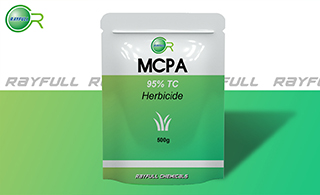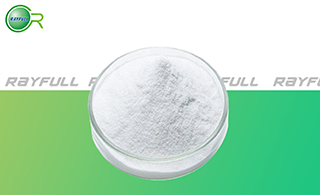MCPA
  ¶юјЧЛДВИ ¶юјЧЛДВИ
Introduction: MCPA is a systemic phenoxy herbicide used to control annual and perennial weeds (including thistle and dock) in cereals, grasslands, trees and turf. As with some of the other phenoxy herbicides, MCPA is an acid, but it is often formulated as a salt such as diethanolamine salt. Unless otherwise indicated, this document will refer to the acid form. The herbicide works by concentrating in the actively growing regions of a plant (meristematic tissue) where it interferes with protein synthesis, cell division and ultimately the growth of the plant.
Common name: MCPA
Another name: Agroxone; 2-METHYL-4-CHLOROPHENOXYACETIC ACID; (4-Chloro-2-methylphenoxy)acetic acid; Zelan; etc.
Chemical name: 4-amino-3,5,6-trichloropyridine-2-carboxylic acid
Empirical formula: C9H9ClO3
Structural formula:

Mol. Weight: 200.62 g/mol
CAS No.: 94-74-6
Specifications
Leading MCPA supplier
MCPA 98% TC
MCPA 95% TC
MCPA 500 g/L amine salt
Packing:
BULK PACKING
Powder: 25kg/Bag, 25kg/Drum, 50kg/Drum etc.
Liquid: 200L/Drum, 20L/Drum, 10L/Drum etc.
SMALL PACKING
Powder: 1kg/Alu bag, 500g/Alu bag, 200g/Alu bag, 100g/Alu bag, 50g/Alu bag, 15g/Alu bag etc.
Liquid: 5L/Drum, 1L/Bottle, 500ml/Bottle, 250ml/Bottle, 100ml/Bottle, 50ml/Bottle etc.
Customerized packing label
MCPA FAO standard
Professional registration
HAZARDS IDENTIFICATION
Hazard statement(s)
H302 (100%): Harmful if swallowed.
H312 (14.83%): Harmful in contact with skin.
H315 (99.52%): Causes skin irritation.
H318 (99.52%): Causes serious eye damage.
H332 (14.83%): Harmful if inhaled.
H400 (98.09%): Very toxic to aquatic life.
H410 (98.09%): Very toxic to aquatic life with long lasting effects.
Precautionary statement(s)
P261: Avoid breathing dust/fume/gas/mist/vapors/spray.
P264: Wash ... thoroughly after handling.
P270: Do not eat, drink or smoke when using this product.
P273: Avoid release to the environment.
P280: Wear protective gloves/protective clothing/eye protection/face protection.
P301+P312: IF SWALLOWED: call a POISON CENTER/doctor/... IF you feel unwell.
P302+P352: IF ON SKIN: wash with plenty of water.
P304+P312: IF INHALED: Call a POISON CENTER/doctor/... if you feel unwell.
P304+P340: IF INHALED: Remove person to fresh air and keep comfortable for breathing.
P305+P351+P338: IF IN EYES: Rinse cautiously with water for several minutes. Remove contact lenses if present and easy to do - continue rinsing.
P312: Call a POISON CENTER or doctor/... if you feel unwell.
P321: Specific treatment (see ... on this label).
P330: Rinse mouth.
P363: Wash contaminated clothing before reuse.
P391: Collect spillage.
P501: Dispose of contents/container to an approved waste disposal plant.
Supplemental Hazard Statements: none.
MAMMALIAN TOXICOLOGY
Acute toxicity: 1) Acute oral LD50 for rats is 962 a.i.mg/kg. 2) Acute dermal LD50 for rats is >4000 a.i.mg/kg. 3) Acute inhalation toxicity LC50 (4 h) for rats is >6.36 a.i.mg/L. 4) Skin irritation: Non-irritating to slightly irritating to skin (rabbits). 5) Eye irritation: Slightly to severely irritating to eyes (rabbits). 6) Skin sensitization for guinea pig: Non-sensitizing.
NOEL: (13 w) for rats is 12 mg/kg/day; (2 y) for mice is 16 mg/kg/day. Other Not carcinogenic. Not genotoxic.
ADI (JMPR) 0-0.1 mg/kg b.w. [2012]
Classification:
WHO Classification: II (Moderately hazardous)
EC Risk Classification: Xn - Harmful: R22, R41; Xi - Irritant: R38; N - Dangerous for the environment: R50, R53
US EPA Classification (formulation): III (Caution - Slightly toxic )
ECOTOXICOLOGY
Effect on birds: Acute oral LD50 for Bobwhite quail is 234 a.i.mg/kg. Effect on fish: Acute LC50 (96 h) for Rainbow trout is >72 a.i.mg/l. Effects on aquatic invertebrates: Acute EC50 (48 h) for Daphnia magna is >190 a.i.mg/l. Effects on algae: Acute 72 hour EC50 for Pseudokirchneriella subcapitata is 79.8 a.i.mg/l. Effects on bees: contact acute 48 hour LD50 is >200 a.i.ҰМg/bee, oral acute 48 hour LD50 is >200 a.i.ҰМg/bee. Effects on earthworms: Acute 14 day LC50 is 325 a.i.mg/kg.
ENVIRONMENTAL FATE
The organic content of soil determines in large part the persistence of MCPA. With less than 10% organic matter in soil, the compound is degraded in one day and, with greater than 10% levels in soil, it takes three to nine days to degrade. No MCPA was detected in forest soils at a depth of 3 to 15 cm 40 days after application. The half-life is five to six days in slightly acidic to slightly alkaline soils. MCPA leaches in most soils, but its mobility increases as organic matter decreases. The compound has been found in well water in Missouri and is of concern to the EPA as a potential groundwater contaminant. In sterilized water, it takes about three weeks for half of the compound to degrade due to the action of sunlight. In rice paddy water however, MCPA is almost totally degraded by aquatic microorganisms in under two weeks. MCPA is absorbed, translocated, and actively broken down by vegetation. Forest litter had 32 ppm 10 months after application. Levels in moss declined to 7% of the initial level within 40 days. The metabolite found in plants is 2-methyl-4-chlorophenol.
Usage: MCPA was introduced by Syngenta AG. It is a herbicide for control of annual and perennial weeds in cereals and other crops. Can also be a pesticide transformation product.
Application: Biochemistry Synthetic auxin (acting like indolylacetic acid). Mode of action Selective, systemic, hormone-type herbicide, absorbed by the leaves and roots, with translocation. Concentrates in the meristematic regions, where it inhibits growth. Uses Post-emergence control of annual and perennial broad-leaved weeds (including thistles and docks) in cereals (alone or undersown), herbage seed crops, flax, rice, vines, peas, potatoes, asparagus, grassland, turf, under fruit trees, and on roadside verges and embankments, etc., at 0.28-2.25 kg/ha. Control of broad-leaved and woody weeds in forestry. Control of aquatic broad-leaved weeds. Often used in combination with other herbicides.
| 






